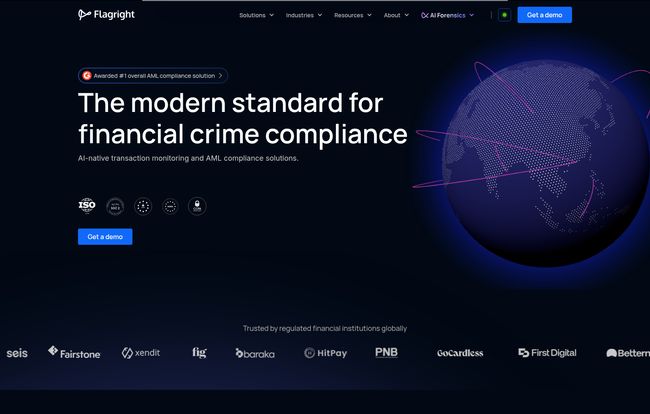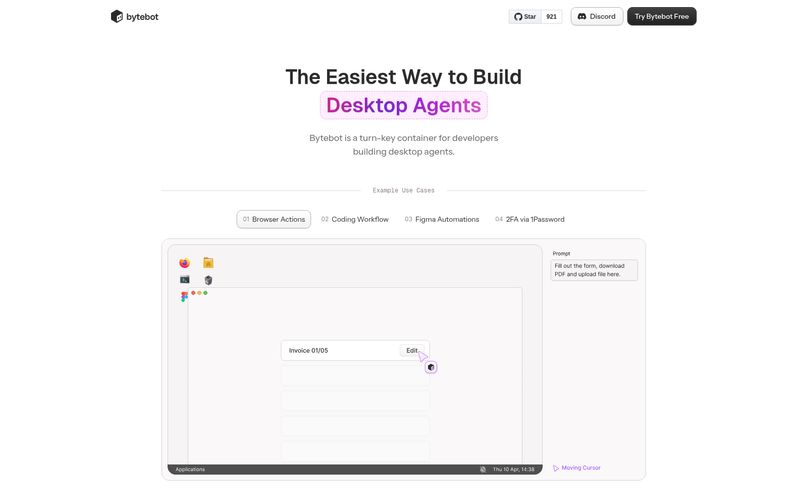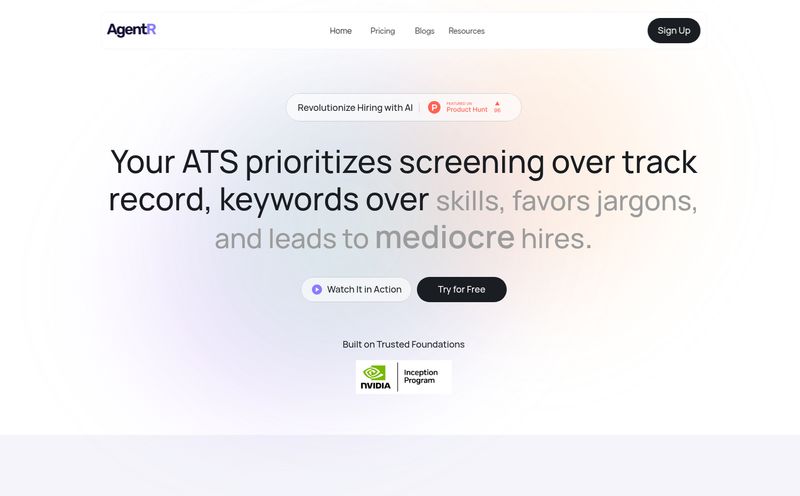If you've spent any time in fincrime or compliance operations, you know the drill. You're staring down a mountain of transaction alerts, and you just know 90% of them are noise. It’s a soul-crushing game of digital whack-a-mole. We call it 'alert fatigue', and it's the fastest way to burn out a good analyst. For years, we've been promised that AI would be our savior, but often it just felt like another layer of complexity bolted onto creaky, old systems.
So, when I first heard about Flagright, I was skeptical. Another AML platform? Groundbreaking. But then I saw the phrase "AI-native" and the claim of bringing GPT to compliance teams for the first time. Okay, that got my attention. It’s not just about sprinkling some AI dust on top; it's about building the entire house on an AI foundation. And that, my friends, could actually change things. So I did what I do best—I went digging.
So What's the Big Deal with "AI-Native" AML Anyway?
We've all seen it. Legacy platforms trying to stay relevant by adding an "AI module". It's a bit like putting a jet engine on a horse-drawn cart. Sure, it's faster, but the wheels are probably going to fly off, and it wasn't designed for that kind of power. An "AI-native" platform, like Flagright claims to be, is different. It’s a purpose-built jet. Every component, from data ingestion to case management, is designed to work with and be enhanced by artificial intelligence from the get-go. This means cleaner data, smarter connections, and insights that older systems just can't see.
This isn't just marketing fluff; it has real-world consequences. It affects the speed of implementation, the accuracy of the results, and the sanity of your ops team. It's the difference between fighting fraud with a flip phone and fighting it with the latest smartphone.
A Look Under the Hood: Flagright's Core Features
Alright, let's get into the guts of the machine. What is Flagright actually doing that's so special? It boils down to a few key areas that work together.
No-Code Rules? Yes, Please.
One of the biggest bottlenecks in compliance has always been the gap between the compliance officers who know the risks and the developers who have to code the rules. Flagright's no-code configurability is a massive olive branch across that divide. The idea is that an analyst, with no programming knowledge, can create, test, and deploy sophisticated monitoring rules. Think about that. No more waiting for weeks in a dev queue to tweak a threshold. The platform boasts a 3-week go-live time, which is frankly absurdly fast for this industry. I've seen implementations drag on for six months to a year. This speed is a direct result of that no-code, user-friendly approach.
The Magic of AI Forensics and Dynamic Scoring
This is the part that really excites me. AI Forensics. It sounds like something out of a sci-fi movie, but the concept is brilliant. Instead of just flagging a transaction and saying "this looks weird," the AI supposedly pieces together a narrative. It connects the dots between a user’s past behavior, their network, and the transaction in question, then presents a summary in plain English. Imagine an alert that comes with its own investigation already started. That's powerful stuff.
This is powered by their dynamic risk scoring. Old systems use static scores. You open an account, you get a risk score, and it rarely changes. Flagright's system constantly adjusts a user's risk profile based on their real-time behavior. It's a living, breathing assessment, which is how risk should have been treated all along.

Visit Flagright
From Transaction Monitoring to Centralized Case Management
All these fancy features would be useless if they were siloed. Flagright seems to understand this by integrating everything into a unified case management dashboard. Real-time transaction monitoring and AML screening feed alerts directly into a workspace where analysts can use the AI Forensics tools to investigate. The workflow appears to be designed to take an analyst from alert to resolution (like filing a Suspicious Activity Report, or SAR) all in one place. It’s about creating a streamlined assembly line for investigations, not a chaotic scavenger hunt across multiple systems.
The Numbers Don't Lie: Putting Flagright's Claims to the Test
Talk is cheap, but data tells a story. The website throws around some seriously impressive figures, and if they're even half true, it's a big deal. Let's break them down.
"We've seen returns on investment from day one, and what keeps us engaged is that Flagright always has something new in store. Whether it was implementing new features or making customizations specific to our business, they consistently delivered."
This kind of feedback, paired with the stats, paints a compelling picture.
| Claimed Metric | What This Actually Means for Your Team |
|---|---|
| 92% false positive reduction | The end of 'alert fatigue'. Your team spends its time on actual risk, not chasing ghosts. This is the holy grail for most ops leaders. |
| 6 minutes investigation time | Radical efficiency. When AI does the initial legwork, human analysts can make faster, better decisions. Small teams can punch way above their weight. |
| 97.9% reduction in operational errors | Fewer mistakes means lower risk and less cleanup. Human error is inevitable, but a good system can almost eliminate it. |
A 92% reduction in false positives? That's not just an improvement; it's a total transformation of a compliance team's daily reality. It's the difference between drowning and having a high-powered speedboat.
So, What’s the Catch? A Realistic Look
Okay, I'm not a complete shill. No platform is perfect. The cons listed are pretty standard for any enterprise software. It requires integration with your existing systems – of course it does, it needs your data. There might be a learning curve for the advanced AI features. Again, that's expected. You don't get a powerful tool without needing to learn how to use it properly. I see that less as a con and more as an investment in your team's skillset.
The real elephant in the room is the pricing. It’s not listed on the website. This is typical for B2B SaaS in the fintech space, as pricing is often tailored to volume, features, and company size. It's not a red flag, but it does mean you can’t just window shop. You’ll have to book a demo to get a quote, which is probably for the best anyway. You wouldn't buy a car without test-driving it, right?
Who Is Flagright Actually For?
I love their tagline: "Small teams feel big. Big teams feel invincible." That nails it. This seems built for two main groups. First, the scaling fintech startup that needs enterprise-grade compliance without a hundred-person team. The speed and no-code aspect are perfect for them. Second, the established financial institution that's tired of its legacy system and wants to make a genuine leap forward in technology and efficiency. The client list backs this up, with names like Payoneer, Tipalti, and PPRO suggesting it's ready for the big leagues.
Frequently Asked Questions about Flagright
- Is Flagright a full replacement for our current AML system?
- For most companies, yes. It's designed as an end-to-end platform covering transaction monitoring, screening, case management, and reporting. It aims to be the central nervous system for your compliance operations.
- How does the "no-code" part actually work for complex rules?
- From what I gather, it uses a visual, logic-based interface. You can set up rules like "If a customer's transaction volume increases by X% in Y days AND the transactions are from a high-risk country, create a medium-priority alert." You build these logical chains without writing a line of code.
- What makes the AI Forensics different from a standard alert investigation?
- Standard alerts give you the 'what' (a suspicious transaction). AI Forensics aims to give you the 'why' by automatically analyzing the user's entire history, connections, and behavior patterns and summarizing it for you. It's about providing context, not just data.
- How much does Flagright cost?
- Pricing isn't public. This is common for enterprise solutions. You'll need to contact their sales team and get a demo for a quote based on your specific needs and transaction volume.
- How long does it really take to get set up?
- They claim a 3-week go-live time, which is incredibly fast. This is likely for a standard implementation. More complex setups might take longer, but it's still a fraction of the time legacy systems typically require.
My Final Thoughts on Flagright
I've been in this space for a long time, and my hype meter is pretty well-calibrated. With Flagright, I have to say, I'm genuinely optimistic. This doesn't feel like just another incremental update. The focus on an AI-native foundation, the practical application of GPT for investigation summaries, and the relentless attention to workflow efficiency (no-code, fast implementation) feel like a real step forward.
It's not magic. It still requires smart people to make smart decisions. But it looks like a tool that finally empowers those people to do their best work instead of getting in their way. If your team is tired of chasing ghosts and fighting with clunky software, Flagright is absolutely worth putting on your demo list. It might just be the lifeline you've been looking for.
Reference and Sources
- Flagright Official Website
- The State of Financial Crime 2022 (for context on industry challenges) - ComplyAdvantage



